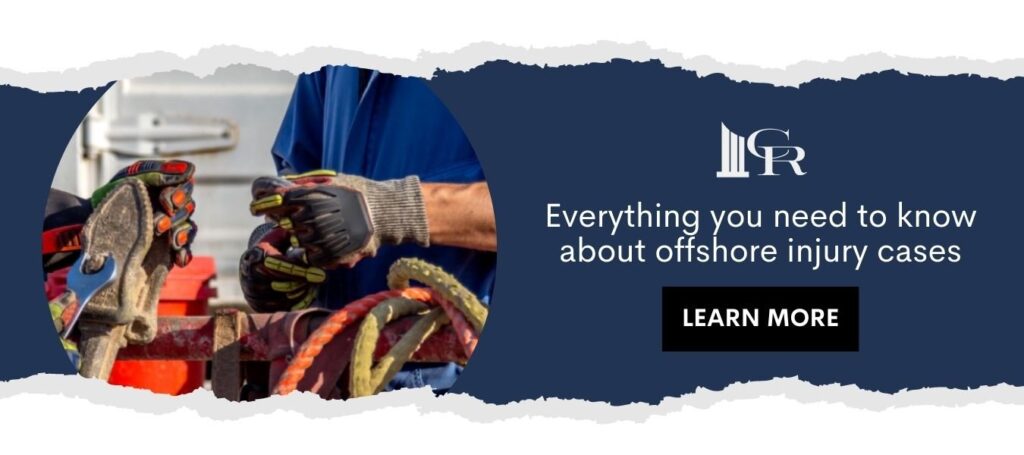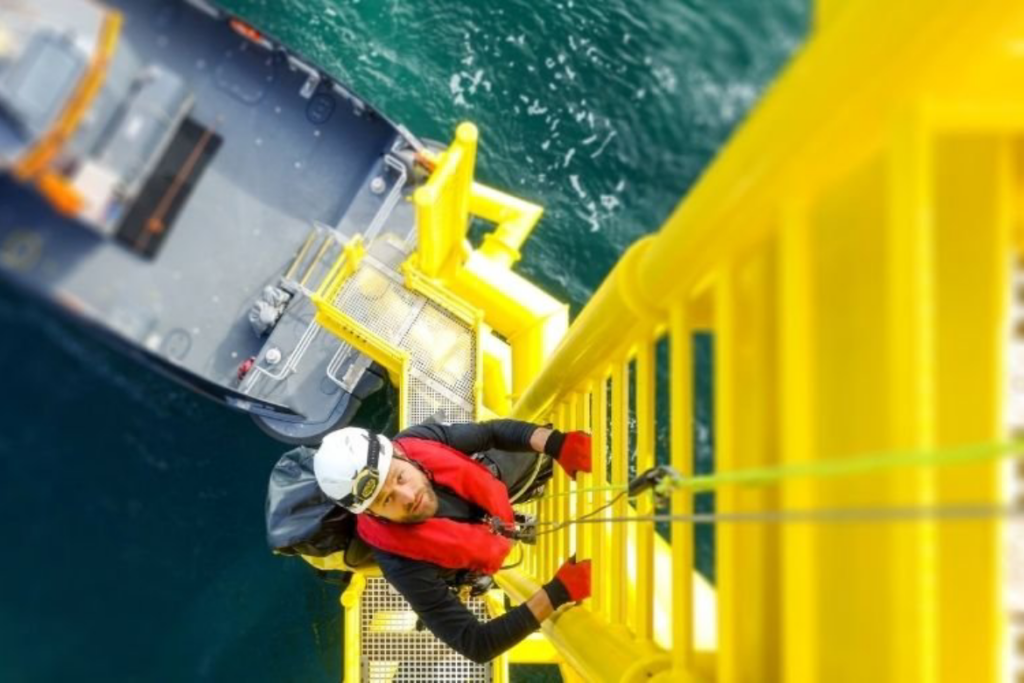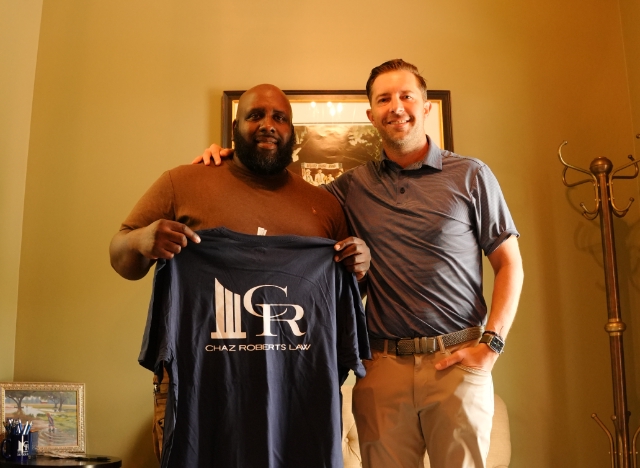Offshore workers are required to work under extreme conditions. They must operate in high-risk locations and often have to face toxic environments. In the United States alone, there are more than 3 million offshore workers, including oil rig operators, drillers, engineers, and geologists.
Here are the most common injuries these workers face.
1- Slip and Fall Injuries at Sea
2- Lifting Injuries on a Vessel
3- Struck by an Object Onboard
4- Caught in Machinery or Equipment
5- Explosion and Fire Injuries on an Offshore Vessel
6- Suffocation, Asphyxiation, or Chemical Inhalation

1- Slip and Fall Injuries at Sea
One of the most common injuries for offshore workers is slips and falls. This can be caused by a number of things, such as wet surfaces, oil spills, or slippery decking. In some cases, these injuries can be fatal.
Falls account for about 23% of maritime injuries, with slippages causing 6-12% of reported injuries, according to studies.
Water and chemicals used onboard may create a slippery surface. Falls are sometimes caused by missing or defective equipment. Brain injuries, fractured bones, and spinal cord damage are all possible consequences of accidents.
In order to prevent slip and fall accidents, offshore workers should wear safety shoes with good grip and always use caution when walking on wet surfaces.
2- Lifting Injuries on a Vessel
Lifting injuries are also common among offshore workers. This can be caused by improper lifting techniques or lifting heavy objects. Back injuries are the most common type of injury, but other injuries, such as rotator cuff tears and hernias, can also occur.
Poor lifting techniques caused by a lack of training can also result in injuries. Lifting accounted for roughly 28% of all reported injuries.
In order to prevent lifting injuries, offshore workers should use proper lifting techniques and take frequent breaks. They should also lift objects in a controlled manner, using their legs rather than their back.
3- Struck by an Object Onboard
Conveyors, barges, oil platforms, and other heavy equipment are all commonplace in the maritime sector. Workers have been injured when struck by a winch, boom, or falling object; and “struck by” injuries account for up to 37% of reported accidents. These sorts of injuries frequently affect the back, neck, and head.
Characters in TV and movies often get injured by falling objects, such as chains, ropes and tools. These injuries can happen to offshore workers too. In fact, 15% of reported maritime injuries were caused by being hit by something on a vessel.
Wearing a hard helmet is the simplest approach to avoid being injured by equipment or falling objects. It is the shipowner's duty under general maritime law to ensure that employees are protected in their work environment; this includes making sure that machinery is maintained in good working order, that safety procedures are followed, and that workers communicate with one another about what they're doing in a specific region.
4- Caught in Machinery or Equipment
Being caught in machinery or equipment is another common hazard for offshore workers. This can happen when someone is working near moving parts or when they become trapped in between two pieces of equipment.
In order to prevent being caught in machinery, offshore workers should always be aware of their surroundings and stay clear of any moving parts. They should also wear the appropriate safety gear, such as gloves, goggles, and a hard hat. If they do become caught in equipment, they should not try to free themselves and should instead wait for help.
The dangers of being caught in machinery are all too real for many offshore workers. In fact, “caught in” injuries account for about 15% of maritime accidents.1 These injuries often occur when workers enter confined spaces, such as the nooks and crannies of machinery.
To prevent getting caught in equipment, offshore workers should always wear protective gear like goggles and gloves if they must enter a confined space. If possible, they should use tools designed to free themselves from entrapment; these tools aren't foolproof but are better than nothing when trapped by heavy equipment.
5- Explosion and Fire Injuries on an Offshore Vessel
Explosion and fire onboard a vessel is another common maritime injury. Explosions caused 40% of all reported casualties between 1998-2007; 4-8% of those explosions were fatal.
Fire is also a common hazard on offshore vessels and can cause extensive damage. In order to prevent explosion and fire injuries, offshore workers should be aware of the dangers of flammable materials and always use caution when working with them. They should also have a plan in place in case of an emergency and know how to evacuate the vessel quickly.
Working in close quarters with flammable materials increases the risk of an explosion or fire on board a vessel. That's why it's so important for offshore workers to be aware of these dangers and take precautions when working with hazardous materials. Explosions and fires account for about 8% of maritime accidents.2
In order to prevent these types of injuries, offshore workers should always wear the appropriate safety gear and be aware of their surroundings. They should also have a plan in place in case of an emergency.
6- Suffocation, Asphyxiation, or Chemical Inhalation
Suffocation, asphyxiation, and chemical inhalation are also common on offshore vessels. These types of injuries account for about 15% of maritime accidents.
To prevent these types of injuries, all nozzles or openings to enclosed spaces should have a gas-tight seal before starting work. Workers should also be sure that any equipment they're using is properly ventilated, so they don't inhale any toxic chemicals. If there is leaking gas on the vessel, workers should move away from it quickly and use breathing equipment until the vessel has been repaired.
Because suffocation, asphyxiation, and chemical inhalation can happen almost anywhere on an offshore vessel, it's important for every worker onboard to stay aware of what's going on around them. They should also be familiar with the emergency evacuation plan in case of an accident.
7- Repetitive Motion Injuries
Repetitive motion injuries are another common hazard for offshore workers. These types of injuries can cause chronic pain and discomfort, and they often require surgery to repair the damage.
Workers can prevent repetitive motion injuries by using proper equipment and maintaining healthy body weight. Lifting heavy objects without giving their muscles time to rest also increases the risk of injury.
In order to reduce the likelihood of repetitive motion injuries, offshore workers should take frequent breaks from strenuous activities and stretch before continuing with their work. In addition, all tools used around the vessel should be well-maintained, so they don't break while being handled.
Repetitive motions account for about 15% of maritime accidents; however, they're also one of the most easily preventable accidents. By reminding themselves to take frequent breaks, workers can reduce their chances of suffering from repetitive motion injuries on an offshore vessel.
Have you been injured offshore?
If you have been injured while working offshore, you may be entitled to compensation. Maritime law is complex, and it can be difficult to know where to turn for help. That's where we come in.
At Chaz Roberts Law, we have years of experience handling maritime accident cases. We understand the laws that govern offshore workers, and we know how to get results for our clients. Contact us today for a free consultation, and let us help you get the money you deserve.



